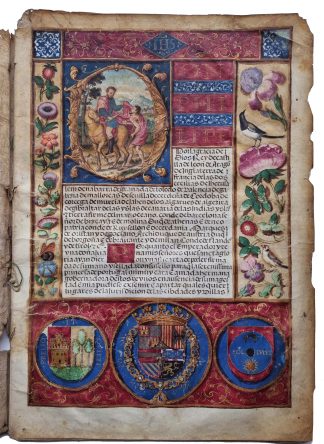PHILIP II OF SPAIN.
Grant of privileges to the town of Huete in Castilla-la-Mancha, including the right to adjudicate over civil and criminal litigation.
Spain, Valladolid, dated 26 August 1558.£4,750.00
Illuminated manuscript on parchment in Spanish.
Folio, 350 x 255mm. 12 leaves (a single complete gathering strung on plaited green, red and yellow cord), single column of 42 lines in a rounded Spanish bookhand, important words or initials in large liquid gold capitals on burgundy panels, ornamental paired penstrokes in upper margin, frontispiece with large initial ‘D’ (opening “Don Philipe por la gracia de Dios …”) in gilt acanthus leaves with a face on its right-hand side, enclosing St. Martin of Tours on horseback dividing his cloak for a beggar, all on deep blue ground. Opening words following this initial in liquid gold on burgundy panels separated by white acanthus scroll work on blue panels, the text framed in gold and with full decorated borders of realistic foliage, insects, a chaffinch and a magpie, with the holy monogram in the centre of the upper border in liquid gold on blue and burgundy ground. The royal arms of Philip II crowned within the collar of the Order of the Golden Fleece (he served as Grand Master of the Order from 1555) in centre of bas-de-page flanked by the probable arms of the city of Huete. An early version of the arms of Heute apparently not otherwise recorded, the left-hand part being the arms of the Castilla-la-Mancha region, and the whole very close to those recorded for the nearby town of Villarrobledo, and an armorial device symbolising the global scale of his empire (see below). Last two leaves with contemporary and near-contemporary additions and endorsements, parchment discoloured and slightly cockled at edges, small spots and a few holes in endleaves, overall in solid condition; contemporary limp vellum binding (somewhat cockled), “No. 201” in scrolling seventeenth- or eighteenth-century hand on front cover.
Philip II of Spain (also known as Philip ‘the prudent’) reigned from 1556 to 1598, also serving as jure uxoris ruler of England from his marriage to Mary Tudor in 1554, until her death in November 1558 a few weeks after this royal grant of privileges was issued. He was the son of Emperor Charles V, completed the building the palace of El Escorial and his reign saw the conquest of the Incas and the Philippines, bringing territories in every continent then known to Europeans under his direct control and ushering in the Spanish ‘Golden Age’ of power and influence. The rule of Ferdinand and Isabella and Charles V are often seen as the very heights of European empire building in the Renaissance, but Philip II pushed this further, holding back the Ottoman advances into Eastern Europe and the Italian coastline, while also extending Spain’s hold over the Americas and annexing Portugal and thus their wide ranging overseas colonies and maritime empire. In fact, the presence of the stylised sun and moon, and inscription “sol lucet” in his armorial device in the right-hand of the bas-de-page of the frontispiece here alludes to the observation of his contemporaries, that only he could truly say “sol mihi semper lucet” (‘the sun always shines on me’).
Unlike the common Spanish royal grants of arms, this is a grant of extensive royal privileges including autonomous legal and juridical authority (Carta de Privilegio Real), for the town of Heute, Castile-la-Mancha, and its inhabitants. Its style of decoration and scribal achievements can be closely located to the royal scribes and illuminators of the Castilian capital of Valladolid – Philip II’s birthplace and the main site of his court. Huete – sited to the south-west of Madrid, as part of a ring of settlements that surround that city, including the sixteenth-century royal winter palace of Aranjuez – was well known to Philip II, and within his circle of immediate influence. An attractive and interesting ms. from the centre of Spanish royal power at its highest grandeur.
In stock






